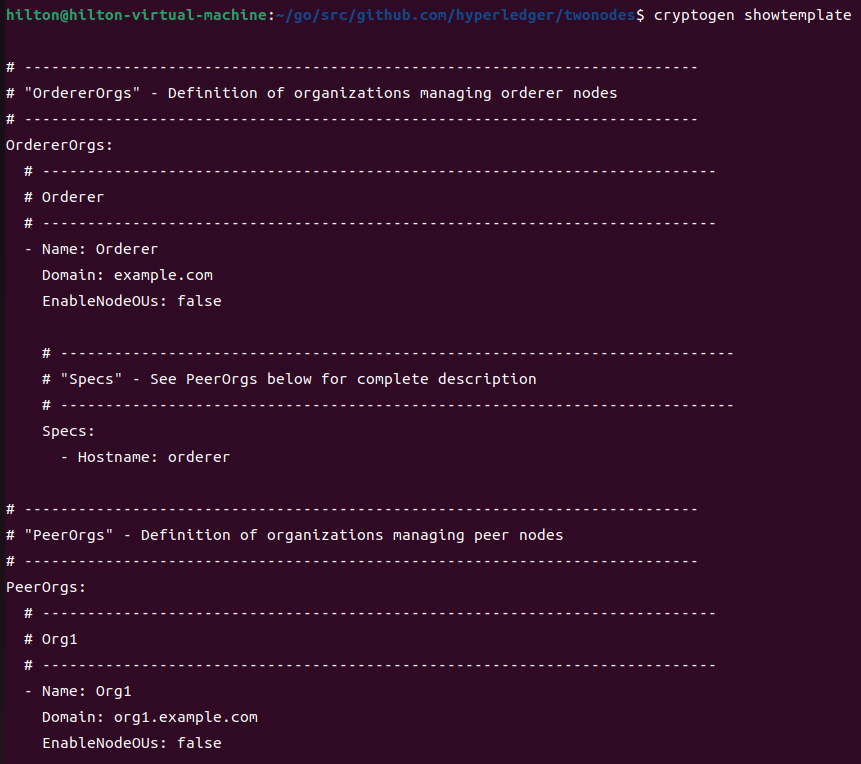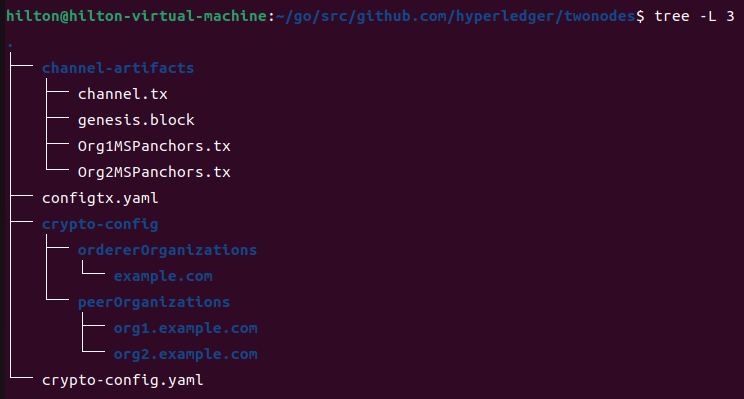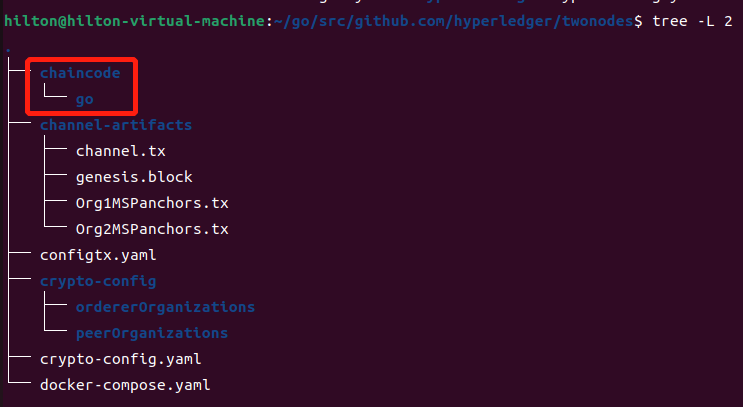前言:本文在搭建好 Hyperledger Fabric v2.2 环境并完成官方测试网络的运行的基础上,开始手动搭建一个 Hyperledger Fabric v2.2 网络。搭建 Hyperledger Fabric v2.2 环境并完成官方测试网络见这篇文章:Hyperledger Fabric v2.2 及其官方测试网络安装全记录。
参考链接:部署一个生产网络 — hyperledger-fabricdocs master 文档
一、生成证书文件
参考链接:cryptogen — hyperledger-fabricdocs master 文档
首先进入 Hyperledger 文件夹:
cd $HOME/go/src/github.com/hyperledger/创建节点文件夹 twonodes:
mkdir twonodes
cd twonodes/使用 cryptogen 的 showtemplate 命令可以查看模板文件:

我们将这个模板文件保存到一个配置文件中,命名为 crypto-config.yaml:
cryptogen showtemplate > crypto-config.yaml查看并修改此配置文件:
vi crypto-config.yaml修改组织单元配置为 true,一共有三处:OrdererOrgs,PeerOrgs的Org1和Org2。修改后保存配置文件。

使用 cryptogen 的 generate 命令可以生成证书文件,执行后在目录下会生成一个文件夹 crypto-config:
cryptogen generate --config=crypto-config.yaml
使用 tree 命令可以查看该文件夹的结构:

cd crypto-config
sudo apt install tree
tree -L 4.
├── ordererOrganizations
│ └── example.com
│ ├── ca
│ │ ├── ca.example.com-cert.pem
│ │ └── priv_sk
│ ├── msp
│ │ ├── admincerts
│ │ ├── cacerts
│ │ ├── config.yaml
│ │ └── tlscacerts
│ ├── orderers
│ │ └── orderer.example.com
│ ├── tlsca
│ │ ├── priv_sk
│ │ └── tlsca.example.com-cert.pem
│ └── users
│ └── [email protected]
└── peerOrganizations
├── org1.example.com
│ ├── ca
│ │ ├── ca.org1.example.com-cert.pem
│ │ └── priv_sk
│ ├── msp
│ │ ├── admincerts
│ │ ├── cacerts
│ │ ├── config.yaml
│ │ └── tlscacerts
│ ├── peers
│ │ └── peer0.org1.example.com
│ ├── tlsca
│ │ ├── priv_sk
│ │ └── tlsca.org1.example.com-cert.pem
│ └── users
│ ├── [email protected]
│ └── [email protected]
└── org2.example.com
├── ca
│ ├── ca.org2.example.com-cert.pem
│ └── priv_sk
├── msp
│ ├── admincerts
│ ├── cacerts
│ ├── config.yaml
│ └── tlscacerts
├── peers
│ └── peer0.org2.example.com
├── tlsca
│ ├── priv_sk
│ └── tlsca.org2.example.com-cert.pem
└── users
├── [email protected]
└── [email protected]二、创建通道
参考链接:使用configtx.yaml创建通道配置 — hyperledger-fabricdocs master 文档
在 Hyperledger Fabric v2.3 中废弃了系统通道的概念,本文以 Hyperledger Fabric v2.2 为例来创建通道。
2.1 修改配置文件
将所需配置文件复制到 twonodes 文件夹下:
cd $HOME/go/src/github.com/hyperledger/twonodes/
cp ../fabric-samples/test-network/configtx/configtx.yaml ./
ls
修改配置文件内容:
vi configtx.yaml将所有的 MSPDir 修改为项目路径,一共有三处:
1.

2.

修改后在 Org1 的 MSPDir 下面添加属性:
AnchorPeers:
- Host: peer0.org1.example.com
Port: 7051
3.

修改后在 Org2 的 MSPDir 下面添加属性:
AnchorPeers:
- Host: peer0.org2.example.com
Port: 7051
将证书文件路径修改为项目路径:

将 Profiles 下面的部分删除,替换为官方文档中的 TwoOrgsOrdererGenesis 和
TwoOrgsChannel,注意缩进:

修改后保存文件。
修改后的最终文件效果:
# Copyright IBM Corp. All Rights Reserved.
#
# SPDX-License-Identifier: Apache-2.0
#
---
################################################################################
#
# Section: Organizations
#
# - This section defines the different organizational identities which will
# be referenced later in the configuration.
#
################################################################################
Organizations:
# SampleOrg defines an MSP using the sampleconfig. It should never be used
# in production but may be used as a template for other definitions
- &OrdererOrg
# DefaultOrg defines the organization which is used in the sampleconfig
# of the fabric.git development environment
Name: OrdererOrg
# ID to load the MSP definition as
ID: OrdererMSP
# MSPDir is the filesystem path which contains the MSP configuration
MSPDir: crypto-config/ordererOrganizations/example.com/msp
# Policies defines the set of policies at this level of the config tree
# For organization policies, their canonical path is usually
# /Channel/<Application|Orderer>/<OrgName>/<PolicyName>
Policies:
Readers:
Type: Signature
Rule: "OR('OrdererMSP.member')"
Writers:
Type: Signature
Rule: "OR('OrdererMSP.member')"
Admins:
Type: Signature
Rule: "OR('OrdererMSP.admin')"
OrdererEndpoints:
- orderer.example.com:7050
- &Org1
# DefaultOrg defines the organization which is used in the sampleconfig
# of the fabric.git development environment
Name: Org1MSP
# ID to load the MSP definition as
ID: Org1MSP
MSPDir: crypto-config/peerOrganizations/org1.example.com/msp
AnchorPeers:
- Host: peer0.org1.example.com
Port: 7051
# For organization policies, their canonical path is usually
# /Channel/<Application|Orderer>/<OrgName>/<PolicyName>
Policies:
Readers:
Type: Signature
Rule: "OR('Org1MSP.admin', 'Org1MSP.peer', 'Org1MSP.client')"
Writers:
Type: Signature
Rule: "OR('Org1MSP.admin', 'Org1MSP.client')"
Admins:
Type: Signature
Rule: "OR('Org1MSP.admin')"
Endorsement:
Type: Signature
Rule: "OR('Org1MSP.peer')"
- &Org2
# DefaultOrg defines the organization which is used in the sampleconfig
# of the fabric.git development environment
Name: Org2MSP
# ID to load the MSP definition as
ID: Org2MSP
MSPDir: crypto-config/peerOrganizations/org2.example.com/msp
AnchorPeers:
- Host: peer0.org2.example.com
Port: 7051
# Policies defines the set of policies at this level of the config tree
# For organization policies, their canonical path is usually
# /Channel/<Application|Orderer>/<OrgName>/<PolicyName>
Policies:
Readers:
Type: Signature
Rule: "OR('Org2MSP.admin', 'Org2MSP.peer', 'Org2MSP.client')"
Writers:
Type: Signature
Rule: "OR('Org2MSP.admin', 'Org2MSP.client')"
Admins:
Type: Signature
Rule: "OR('Org2MSP.admin')"
Endorsement:
Type: Signature
Rule: "OR('Org2MSP.peer')"
################################################################################
#
# SECTION: Capabilities
#
# - This section defines the capabilities of fabric network. This is a new
# concept as of v1.1.0 and should not be utilized in mixed networks with
# v1.0.x peers and orderers. Capabilities define features which must be
# present in a fabric binary for that binary to safely participate in the
# fabric network. For instance, if a new MSP type is added, newer binaries
# might recognize and validate the signatures from this type, while older
# binaries without this support would be unable to validate those
# transactions. This could lead to different versions of the fabric binaries
# having different world states. Instead, defining a capability for a channel
# informs those binaries without this capability that they must cease
# processing transactions until they have been upgraded. For v1.0.x if any
# capabilities are defined (including a map with all capabilities turned off)
# then the v1.0.x peer will deliberately crash.
#
################################################################################
Capabilities:
# Channel capabilities apply to both the orderers and the peers and must be
# supported by both.
# Set the value of the capability to true to require it.
Channel: &ChannelCapabilities
# V2_0 capability ensures that orderers and peers behave according
# to v2.0 channel capabilities. Orderers and peers from
# prior releases would behave in an incompatible way, and are therefore
# not able to participate in channels at v2.0 capability.
# Prior to enabling V2.0 channel capabilities, ensure that all
# orderers and peers on a channel are at v2.0.0 or later.
V2_0: true
# Orderer capabilities apply only to the orderers, and may be safely
# used with prior release peers.
# Set the value of the capability to true to require it.
Orderer: &OrdererCapabilities
# V2_0 orderer capability ensures that orderers behave according
# to v2.0 orderer capabilities. Orderers from
# prior releases would behave in an incompatible way, and are therefore
# not able to participate in channels at v2.0 orderer capability.
# Prior to enabling V2.0 orderer capabilities, ensure that all
# orderers on channel are at v2.0.0 or later.
V2_0: true
# Application capabilities apply only to the peer network, and may be safely
# used with prior release orderers.
# Set the value of the capability to true to require it.
Application: &ApplicationCapabilities
# V2_0 application capability ensures that peers behave according
# to v2.0 application capabilities. Peers from
# prior releases would behave in an incompatible way, and are therefore
# not able to participate in channels at v2.0 application capability.
# Prior to enabling V2.0 application capabilities, ensure that all
# peers on channel are at v2.0.0 or later.
V2_0: true
################################################################################
#
# SECTION: Application
#
# - This section defines the values to encode into a config transaction or
# genesis block for application related parameters
#
################################################################################
Application: &ApplicationDefaults
# Organizations is the list of orgs which are defined as participants on
# the application side of the network
Organizations:
# Policies defines the set of policies at this level of the config tree
# For Application policies, their canonical path is
# /Channel/Application/<PolicyName>
Policies:
Readers:
Type: ImplicitMeta
Rule: "ANY Readers"
Writers:
Type: ImplicitMeta
Rule: "ANY Writers"
Admins:
Type: ImplicitMeta
Rule: "MAJORITY Admins"
LifecycleEndorsement:
Type: ImplicitMeta
Rule: "MAJORITY Endorsement"
Endorsement:
Type: ImplicitMeta
Rule: "MAJORITY Endorsement"
Capabilities:
<<: *ApplicationCapabilities
################################################################################
#
# SECTION: Orderer
#
# - This section defines the values to encode into a config transaction or
# genesis block for orderer related parameters
#
################################################################################
Orderer: &OrdererDefaults
# Orderer Type: The orderer implementation to start
OrdererType: etcdraft
# Addresses used to be the list of orderer addresses that clients and peers
# could connect to. However, this does not allow clients to associate orderer
# addresses and orderer organizations which can be useful for things such
# as TLS validation. The preferred way to specify orderer addresses is now
# to include the OrdererEndpoints item in your org definition
Addresses:
- orderer.example.com:7050
EtcdRaft:
Consenters:
- Host: orderer.example.com
Port: 7050
ClientTLSCert: crypto-config/ordererOrganizations/example.com/orderers/orderer.example.com/tls/server.crt
ServerTLSCert: crypto-config/ordererOrganizations/example.com/orderers/orderer.example.com/tls/server.crt
# Batch Timeout: The amount of time to wait before creating a batch
BatchTimeout: 2s
# Batch Size: Controls the number of messages batched into a block
BatchSize:
# Max Message Count: The maximum number of messages to permit in a batch
MaxMessageCount: 10
# Absolute Max Bytes: The absolute maximum number of bytes allowed for
# the serialized messages in a batch.
AbsoluteMaxBytes: 99 MB
# Preferred Max Bytes: The preferred maximum number of bytes allowed for
# the serialized messages in a batch. A message larger than the preferred
# max bytes will result in a batch larger than preferred max bytes.
PreferredMaxBytes: 512 KB
# Organizations is the list of orgs which are defined as participants on
# the orderer side of the network
Organizations:
# Policies defines the set of policies at this level of the config tree
# For Orderer policies, their canonical path is
# /Channel/Orderer/<PolicyName>
Policies:
Readers:
Type: ImplicitMeta
Rule: "ANY Readers"
Writers:
Type: ImplicitMeta
Rule: "ANY Writers"
Admins:
Type: ImplicitMeta
Rule: "MAJORITY Admins"
# BlockValidation specifies what signatures must be included in the block
# from the orderer for the peer to validate it.
BlockValidation:
Type: ImplicitMeta
Rule: "ANY Writers"
################################################################################
#
# CHANNEL
#
# This section defines the values to encode into a config transaction or
# genesis block for channel related parameters.
#
################################################################################
Channel: &ChannelDefaults
# Policies defines the set of policies at this level of the config tree
# For Channel policies, their canonical path is
# /Channel/<PolicyName>
Policies:
# Who may invoke the 'Deliver' API
Readers:
Type: ImplicitMeta
Rule: "ANY Readers"
# Who may invoke the 'Broadcast' API
Writers:
Type: ImplicitMeta
Rule: "ANY Writers"
# By default, who may modify elements at this config level
Admins:
Type: ImplicitMeta
Rule: "MAJORITY Admins"
# Capabilities describes the channel level capabilities, see the
# dedicated Capabilities section elsewhere in this file for a full
# description
Capabilities:
<<: *ChannelCapabilities
################################################################################
#
# Profile
#
# - Different configuration profiles may be encoded here to be specified
# as parameters to the configtxgen tool
#
################################################################################
Profiles:
TwoOrgsOrdererGenesis:
<<: *ChannelDefaults
Orderer:
<<: *OrdererDefaults
Organizations:
- *OrdererOrg
Capabilities:
<<: *OrdererCapabilities
Consortiums:
SampleConsortium:
Organizations:
- *Org1
- *Org2
TwoOrgsChannel:
Consortium: SampleConsortium
<<: *ChannelDefaults
Application:
<<: *ApplicationDefaults
Organizations:
- *Org1
- *Org2
Capabilities:
<<: *ApplicationCapabilities2.2 生成所需文件
使用 configtxgen 来生成通道配置。参考链接:configtxgen — hyperledger-fabricdocs master 文档
生成创世块文件:
configtxgen -profile TwoOrgsOrdererGenesis -outputBlock ./channel-artifacts/genesis.block -channelID fabric-channel
生成通道文件:
configtxgen -profile TwoOrgsChannel -outputCreateChannelTx ./channel-artifacts/channel.tx -channelID mychannel
生成锚节点文件:
configtxgen -profile TwoOrgsChannel -outputAnchorPeersUpdate ./channel-artifacts/Org1MSPanchors.tx -channelID mychannel -asOrg Org1MSP
configtxgen -profile TwoOrgsChannel -outputAnchorPeersUpdate ./channel-artifacts/Org2MSPanchors.tx -channelID mychannel -asOrg Org2MSP
此时在 twonodes 文件夹下会生成一个 channel-artifacts 文件夹,文件夹内有四个文件,分别是创世块文件、通道文件、Org1 和 Org2 的锚点文件。可以用 tree 命令来查看文件夹的结构:

三、部署节点
参考链接:部署一个生产网络 — hyperledger-fabricdocs master 文档
3.1 创建一个 peer 节点
在 twonodes 文件夹下新建一个名为 docker-compose.yaml 的文件:
touch docker-compose.yaml然后将下列内容写进文件中:
version: '2.4'
volumes:
orderer.example.com:
peer0.org1.example.com:
peer0.org2.example.com:
networks:
test:
name: twonodes_test
services:
orderer.example.com:
container_name: orderer.example.com
image: hyperledger/fabric-orderer:latest
labels:
service: hyperledger-fabric
environment:
- FABRIC_LOGGING_SPEC=INFO
- ORDERER_GENERAL_LISTENADDRESS=0.0.0.0
- ORDERER_GENERAL_LISTENPORT=7050
- ORDERER_GENERAL_LOCALMSPID=OrdererMSP
- ORDERER_GENERAL_LOCALMSPDIR=/var/hyperledger/orderer/msp
# enabled TLS
- ORDERER_GENERAL_TLS_ENABLED=true
- ORDERER_GENERAL_TLS_PRIVATEKEY=/var/hyperledger/orderer/tls/server.key
- ORDERER_GENERAL_TLS_CERTIFICATE=/var/hyperledger/orderer/tls/server.crt
- ORDERER_GENERAL_TLS_ROOTCAS=[/var/hyperledger/orderer/tls/ca.crt]
- ORDERER_KAFKA_TOPIC_REPLICATIONFACTOR=1
- ORDERER_KAFKA_VERBOSE=true
- ORDERER_GENERAL_CLUSTER_CLIENTCERTIFICATE=/var/hyperledger/orderer/tls/server.crt
- ORDERER_GENERAL_CLUSTER_CLIENTPRIVATEKEY=/var/hyperledger/orderer/tls/server.key
- ORDERER_GENERAL_CLUSTER_ROOTCAS=[/var/hyperledger/orderer/tls/ca.crt]
- ORDERER_GENERAL_GENESISMETHOD=file
- ORDERER_GENERAL_GENESISFILE=/var/hyperledger/orderer/orderer.genesis.block
- ORDERER_CHANNELPARTICIPATION_ENABLED=true
- ORDERER_ADMIN_TLS_ENABLED=true
- ORDERER_ADMIN_TLS_CERTIFICATE=/var/hyperledger/orderer/tls/server.crt
- ORDERER_ADMIN_TLS_PRIVATEKEY=/var/hyperledger/orderer/tls/server.key
- ORDERER_ADMIN_TLS_ROOTCAS=[/var/hyperledger/orderer/tls/ca.crt]
- ORDERER_ADMIN_TLS_CLIENTROOTCAS=[/var/hyperledger/orderer/tls/ca.crt]
- ORDERER_ADMIN_LISTENADDRESS=0.0.0.0:7053
working_dir: /opt/gopath/src/github.com/hyperledger/fabric
command: orderer
volumes:
- ./channel-artifacts/genesis.block:/var/hyperledger/orderer/orderer.genesis.block
- ./crypto-config/ordererOrganizations/example.com/orderers/orderer.example.com/msp:/var/hyperledger/orderer/msp
- ./crypto-config/ordererOrganizations/example.com/orderers/orderer.example.com/tls/:/var/hyperledger/orderer/tls
- orderer.example.com:/var/hyperledger/production/orderer
ports:
- 7050:7050
- 7053:7053 #存疑!
networks:
- test
peer0.org1.example.com:
container_name: peer0.org1.example.com
image: hyperledger/fabric-peer:latest
labels:
service: hyperledger-fabric
environment:
#Generic peer variables
- CORE_VM_ENDPOINT=unix:///host/var/run/docker.sock
- CORE_VM_DOCKER_HOSTCONFIG_NETWORKMODE=twonodes_test
- FABRIC_LOGGING_SPEC=INFO
#- FABRIC_LOGGING_SPEC=DEBUG
- CORE_PEER_TLS_ENABLED=true
- CORE_PEER_PROFILE_ENABLED=true
- CORE_PEER_TLS_CERT_FILE=/etc/hyperledger/fabric/tls/server.crt
- CORE_PEER_TLS_KEY_FILE=/etc/hyperledger/fabric/tls/server.key
- CORE_PEER_TLS_ROOTCERT_FILE=/etc/hyperledger/fabric/tls/ca.crt
# Peer specific variabes
- CORE_PEER_ID=peer0.org1.example.com
- CORE_PEER_ADDRESS=peer0.org1.example.com:7051
- CORE_PEER_LISTENADDRESS=0.0.0.0:7051
- CORE_PEER_CHAINCODEADDRESS=peer0.org1.example.com:7052
- CORE_PEER_CHAINCODELISTENADDRESS=0.0.0.0:7052
- CORE_PEER_GOSSIP_BOOTSTRAP=peer0.org1.example.com:7051
- CORE_PEER_GOSSIP_EXTERNALENDPOINT=peer0.org1.example.com:7051
- CORE_PEER_LOCALMSPID=Org1MSP
volumes:
- /var/run/docker.sock:/host/var/run/docker.sock
- ./crypto-config/peerOrganizations/org1.example.com/peers/peer0.org1.example.com/msp:/etc/hyperledger/fabric/msp
- ./crypto-config/peerOrganizations/org1.example.com/peers/peer0.org1.example.com/tls:/etc/hyperledger/fabric/tls
- peer0.org1.example.com:/var/hyperledger/production
working_dir: /opt/gopath/src/github.com/hyperledger/fabric/peer
command: peer node start
ports:
- 7051:7051
networks:
- test
peer0.org2.example.com:
container_name: peer0.org2.example.com
image: hyperledger/fabric-peer:latest
labels:
service: hyperledger-fabric
environment:
#Generic peer variables
- CORE_VM_ENDPOINT=unix:///host/var/run/docker.sock
- CORE_VM_DOCKER_HOSTCONFIG_NETWORKMODE=twonodes_test
- FABRIC_LOGGING_SPEC=INFO
#- FABRIC_LOGGING_SPEC=DEBUG
- CORE_PEER_TLS_ENABLED=true
- CORE_PEER_PROFILE_ENABLED=true
- CORE_PEER_TLS_CERT_FILE=/etc/hyperledger/fabric/tls/server.crt
- CORE_PEER_TLS_KEY_FILE=/etc/hyperledger/fabric/tls/server.key
- CORE_PEER_TLS_ROOTCERT_FILE=/etc/hyperledger/fabric/tls/ca.crt
# Peer specific variabes
- CORE_PEER_ID=peer0.org2.example.com
- CORE_PEER_ADDRESS=peer0.org2.example.com:9051
- CORE_PEER_LISTENADDRESS=0.0.0.0:9051
- CORE_PEER_CHAINCODEADDRESS=peer0.org2.example.com:9052
- CORE_PEER_CHAINCODELISTENADDRESS=0.0.0.0:9052
- CORE_PEER_GOSSIP_EXTERNALENDPOINT=peer0.org2.example.com:9051
- CORE_PEER_GOSSIP_BOOTSTRAP=peer0.org2.example.com:9051
- CORE_PEER_LOCALMSPID=Org2MSP
volumes:
- /var/run/docker.sock:/host/var/run/docker.sock
- ./crypto-config/peerOrganizations/org2.example.com/peers/peer0.org2.example.com/msp:/etc/hyperledger/fabric/msp
- ./crypto-config/peerOrganizations/org2.example.com/peers/peer0.org2.example.com/tls:/etc/hyperledger/fabric/tls
- peer0.org2.example.com:/var/hyperledger/production
working_dir: /opt/gopath/src/github.com/hyperledger/fabric/peer
command: peer node start
ports:
- 9051:9051
networks:
- test
cli1:
container_name: cli1
image: hyperledger/fabric-tools:latest
tty: true
stdin_open: true
environment:
- GOPATH=/opt/gopath
- CORE_VM_ENDPOINT=unix:///host/var/run/docker.sock
- FABRIC_LOGGING_SPEC=INFO
- CORE_PEER_ID=cli1
- CORE_PEER_ADDRESS=peer0.org1.example.com:7051
- CORE_PEER_LOCALMSPID=Org1MSP
- CORE_PEER_TLS_ENABLED=true
- CORE_PEER_TLS_CERT_FILE=/opt/gopath/src/github.com/hyperledger/fabric/peer/crypto/peerOrganizations/org1.example.com/peers/peer0.org1.example.com/tls/server.crt
- CORE_PEER_TLS_KEY_FILE=/opt/gopath/src/github.com/hyperledger/fabric/peer/crypto/peerOrganizations/org1.example.com/peers/peer0.org1.example.com/tls/server.key
- CORE_PEER_TLS_ROOTCERT_FILE=/opt/gopath/src/github.com/hyperledger/fabric/peer/crypto/peerOrganizations/org1.example.com/peers/peer0.org1.example.com/tls/ca.crt
- CORE_PEER_MSPCONFIGPATH=/opt/gopath/src/github.com/hyperledger/fabric/peer/crypto/peerOrganizations/org1.example.com/users/[email protected]/msp
working_dir: /opt/gopath/src/github.com/hyperledger/fabric/peer
command: /bin/bash
volumes:
- /var/run/:/host/var/run/
- ./chaincode/go/:/opt/gopath/src/github.com/hyperledger/fabric-cluster/chaincode/go
- ./crypto-config:/opt/gopath/src/github.com/hyperledger/fabric/peer/crypto/
- ./channel-artifacts:/opt/gopath/src/github.com/hyperledger/fabric/peer/channel-artifacts
networks:
- test
cli2:
container_name: cli2
image: hyperledger/fabric-tools:latest
tty: true
stdin_open: true
environment:
- GOPATH=/opt/gopath
- CORE_VM_ENDPOINT=unix:///host/var/run/docker.sock
- FABRIC_LOGGING_SPEC=INFO
- CORE_PEER_ID=cli2
- CORE_PEER_ADDRESS=peer0.org2.example.com:9051
- CORE_PEER_LOCALMSPID=Org2MSP
- CORE_PEER_TLS_ENABLED=true
- CORE_PEER_TLS_CERT_FILE=/opt/gopath/src/github.com/hyperledger/fabric/peer/crypto/peerOrganizations/org2.example.com/peers/peer0.org2.example.com/tls/server.crt
- CORE_PEER_TLS_KEY_FILE=/opt/gopath/src/github.com/hyperledger/fabric/peer/crypto/peerOrganizations/org2.example.com/peers/peer0.org2.example.com/tls/server.key
- CORE_PEER_TLS_ROOTCERT_FILE=/opt/gopath/src/github.com/hyperledger/fabric/peer/crypto/peerOrganizations/org2.example.com/peers/peer0.org2.example.com/tls/ca.crt
- CORE_PEER_MSPCONFIGPATH=/opt/gopath/src/github.com/hyperledger/fabric/peer/crypto/peerOrganizations/org2.example.com/users/[email protected]/msp
working_dir: /opt/gopath/src/github.com/hyperledger/fabric/peer
command: /bin/bash
volumes:
- /var/run/:/host/var/run/
- ./chaincode/go/:/opt/gopath/src/github.com/hyperledger/fabric-cluster/chaincode/go
- ./crypto-config:/opt/gopath/src/github.com/hyperledger/fabric/peer/crypto/
- ./channel-artifacts:/opt/gopath/src/github.com/hyperledger/fabric/peer/channel-artifacts
networks:
- test启动节点:
docker-compose up -d
可以看到,一个排序节点,两个终端,两个 peer 节点全部启动完成。
可以查看开启的容器:
docker ps -atwonodes 文件夹下会出现 chaincode/go/ 文件夹,链码文件将存于此处。

3.2 加入通道
参考链接:peer channel — hyperledger-fabricdocs master 文档
进入 Org1 的 Cli1 (终端节点):
docker exec -it cli1 bash
创建一个通道:
peer channel create -o orderer.example.com:7050 -c mychannel -f ./channel-artifacts/channel.tx --tls true --cafile /opt/gopath/src/github.com/hyperledger/fabric/peer/crypto/ordererOrganizations/example.com/msp/tlscacerts/tlsca.example.com-cert.pem
查看生成的通道文件:

退出容器:
exit将通道文件复制到本地目录下:
docker cp cli1:/opt/gopath/src/github.com/hyperledger/fabric/peer/mychannel.block ./ 将通道文件复制到 cli2 中:
docker cp ./mychannel.block cli2:/opt/gopath/src/github.com/hyperledger/fabric/peer/进入 Org2 的 Cli2 (终端节点):
docker exec -it cli2 bash加入通道:
peer channel join -b mychannel.block新开一个终端,同样操作对 Cli1:
docker exec -it cli1 bashpeer channel join -b mychannel.block

更新各自锚节点:
在 Org1 终端:
peer channel update -o orderer.example.com:7050 -c mychannel -f ./channel-artifacts/Org1MSPanchors.tx --tls --cafile /opt/gopath/src/github.com/hyperledger/fabric/peer/crypto/ordererOrganizations/example.com/orderers/orderer.example.com/msp/tlscacerts/tlsca.example.com-cert.pem在 Org2 终端:
peer channel update -o orderer.example.com:7050 -c mychannel -f ./channel-artifacts/Org2MSPanchors.tx --tls --cafile /opt/gopath/src/github.com/hyperledger/fabric/peer/crypto/ordererOrganizations/example.com/orderers/orderer.example.com/msp/tlscacerts/tlsca.example.com-cert.pem3.3 链码的生命周期
参考链接:Fabric 链码生命周期 — hyperledger-fabricdocs master 文档
新终端中,进入官方项目链码路径:
cd $HOME/go/src/github.com/hyperledger/fabric-samples/chaincode/将 sacc 中的 sacc.go 复制到链码存放路径中:
cd sacc/
sudo cp sacc.go $HOME/go/src/github.com/hyperledger/twonodes/chaincode/go/
cd $HOME/go/src/github.com/hyperledger/twonodes/修改 go 国内代理:
docker exec -it cli1 bash
cd /opt/gopath/src/github.com/hyperledger/fabric-cluster/chaincode/go/
go env -w GOPROXY=https://goproxy.cn,direct
go mod init
go mod vendordocker exec -it cli2 bash
cd /opt/gopath/src/github.com/hyperledger/fabric-cluster/chaincode/go/
go env -w GOPROXY=https://goproxy.cn,direct
go mod init
go mod vendor若在 go mod vendor 时出现如下报错:

根据提示执行如下两句即可:
go get github.com/hyperledger/fabric-chaincode-go/shim
go get github.com/hyperledger/fabric-protos-go/peer
go mod vendor打包链码:
cd /opt/gopath/src/github.com/hyperledger/fabric/peer/peer lifecycle chaincode package sacc.tar.gz \
--path github.com/hyperledger/fabric-cluster/chaincode/go/ \
--label sacc_1打包好后路径下会生成打包文件:

退出容器:
exit将打包文件复制到本地:
docker cp cli2:/opt/gopath/src/github.com/hyperledger/fabric/peer/sacc.tar.gz ./将打包文件复制到 cli1 的终端里:
docker cp sacc.tar.gz cli1:/opt/gopath/src/github.com/hyperledger/fabric/peer安装链码:
docker exec -it cli1 bash
peer lifecycle chaincode install sacc.tar.gz
exit
docker exec -it cli2 bash
peer lifecycle chaincode install sacc.tar.gz安装好后获得 package-id:

sacc_1:454c7a16634bc11fdbb51fc51ce6d9ffb2719b2c06f03b5f4cd7a1faf1c40e1f
组织批准:
peer lifecycle chaincode approveformyorg --channelID mychannel --name sacc --version 1.0 --init-required --package-id 在此处嵌入你的package-id --sequence 1 --tls true --cafile /opt/gopath/src/github.com/hyperledger/fabric/peer/crypto/ordererOrganizations/example.com/orderers/orderer.example.com/msp/tlscacerts/tlsca.example.com-cert.pem
docker exec -it cli1 bash
peer lifecycle chaincode approveformyorg --channelID mychannel --name sacc --version 1.0 --init-required --package-id 在此处嵌入你的package-id --sequence 1 --tls true --cafile /opt/gopath/src/github.com/hyperledger/fabric/peer/crypto/ordererOrganizations/example.com/orderers/orderer.example.com/msp/tlscacerts/tlsca.example.com-cert.pem
验证是否批准成功:
peer lifecycle chaincode checkcommitreadiness --channelID mychannel --name sacc --version 1.0 --init-required --sequence 1 --tls true --cafile /opt/gopath/src/github.com/hyperledger/fabric/peer/crypto/ordererOrganizations/example.com/orderers/orderer.example.com/msp/tlscacerts/tlsca.example.com-cert.pem --output json
提交 commit:选择其中一个节点提交即可
peer lifecycle chaincode commit -o orderer.example.com:7050 --channelID mychannel --name sacc --version 1.0 --sequence 1 --init-required --tls true --cafile /opt/gopath/src/github.com/hyperledger/fabric/peer/crypto/ordererOrganizations/example.com/orderers/orderer.example.com/msp/tlscacerts/tlsca.example.com-cert.pem --peerAddresses peer0.org1.example.com:7051 --tlsRootCertFiles /opt/gopath/src/github.com/hyperledger/fabric/peer/crypto/peerOrganizations/org1.example.com/peers/peer0.org1.example.com/tls/ca.crt --peerAddresses peer0.org2.example.com:9051 --tlsRootCertFiles /opt/gopath/src/github.com/hyperledger/fabric/peer/crypto/peerOrganizations/org2.example.com/peers/peer0.org2.example.com/tls/ca.crt
3.4 链码调用
链码调用:
peer chaincode invoke -o orderer.example.com:7050 --isInit --ordererTLSHostnameOverride orderer.example.com --tls true --cafile /opt/gopath/src/github.com/hyperledger/fabric/peer/crypto/ordererOrganizations/example.com/orderers/orderer.example.com/msp/tlscacerts/tlsca.example.com-cert.pem -C mychannel -n sacc --peerAddresses peer0.org1.example.com:7051 --tlsRootCertFiles /opt/gopath/src/github.com/hyperledger/fabric/peer/crypto/peerOrganizations/org1.example.com/peers/peer0.org1.example.com/tls/ca.crt --peerAddresses peer0.org2.example.com:9051 --tlsRootCertFiles /opt/gopath/src/github.com/hyperledger/fabric/peer/crypto/peerOrganizations/org2.example.com/peers/peer0.org2.example.com/tls/ca.crt -c '{"Args":["a","bb"]}'
在组织2上,可以查询到刚刚在组织1提交的键值对:
exit
docker exec -it cli2 bash
peer chaincode query -C mychannel -n sacc -c '{"Args":["query","a"]}'
可以在组织2上进行数据覆盖,修改键值对为["a","cc"]:
peer chaincode invoke -o orderer.example.com:7050 --tls true --cafile /opt/gopath/src/github.com/hyperledger/fabric/peer/crypto/ordererOrganizations/example.com/orderers/orderer.example.com/msp/tlscacerts/tlsca.example.com-cert.pem -C mychannel -n sacc --peerAddresses peer0.org1.example.com:7051 --tlsRootCertFiles /opt/gopath/src/github.com/hyperledger/fabric/peer/crypto/peerOrganizations/org1.example.com/peers/peer0.org1.example.com/tls/ca.crt --peerAddresses peer0.org2.example.com:9051 --tlsRootCertFiles /opt/gopath/src/github.com/hyperledger/fabric/peer/crypto/peerOrganizations/org2.example.com/peers/peer0.org2.example.com/tls/ca.crt -c '{"Args":["set","a","cc"]}'
在组织1上,可以查询到刚刚在组织2修改的键值对:
exit
docker exec -it cli1 bash
peer chaincode query -C mychannel -n sacc -c '{"Args":["query","a"]}'
至此,手动搭建的 Hyperledger Fabric v2.2 网络已经测试完毕。